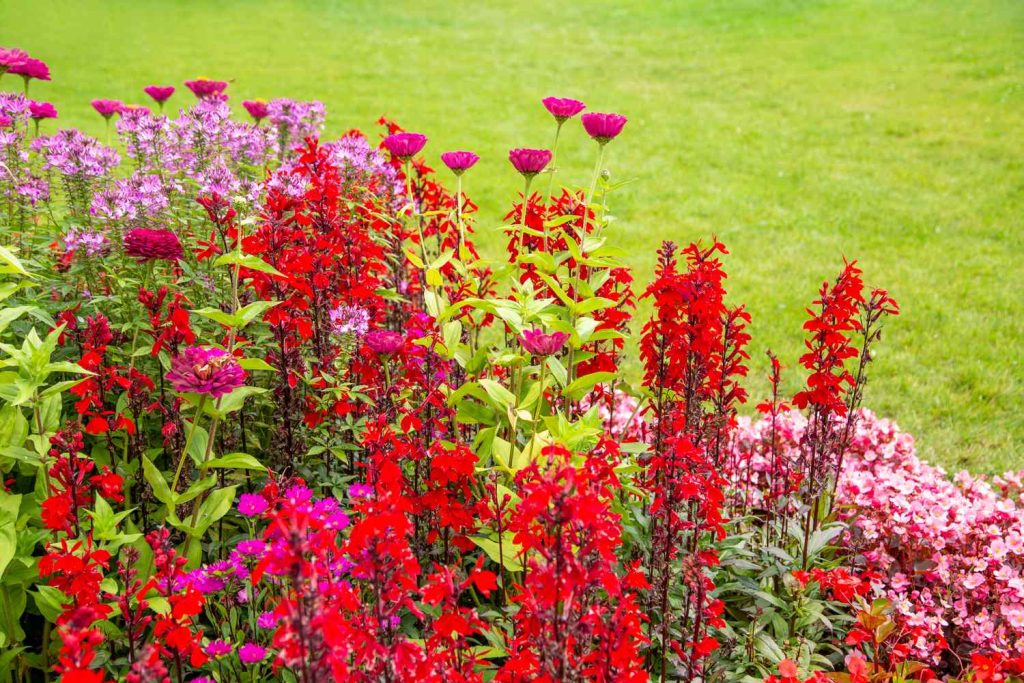:max_bytes(150000):strip_icc():format(jpeg)/garden-color-scheme-GettyImages-1222452678-3df51a0284ad452bab9f7e467db6e288.jpg)
Key Takeaways
- Your home’s exterior color scheme and architectural style play a role in the colors you should choose for your garden.
- Consider using artistic principles like the color wheel and complementary colors to enhance your garden’s aesthetic.
- Adding texture and paying attention to the plant’s foliage can make even a simple, monochromatic color scheme intriguing.
- You can change the colors with the seasons and experiment with new things—but most of all, choose colors that you love.
There’s a lot to consider when you’re choosing plants for your garden—from the plant’s light and water requirements to the perennial vs. annual debate. But probably just as important is the colors of the flowers and foliage you add to your garden. Whether you’re looking for a literal rainbow or want to keep it simple and subdued, the colors you choose go a long way toward creating curb appeal (and you-love-it appeal) to your garden.
“Some of us just want a colorful riot in our yard,” says Amy Krane, architectural color consultant at Amy Krane Color and host of the podcast “Let’s Talk Paint Color.” “I consider garden design as a form of self-expression, and far be it for me to pour water on someone’s personal statement. But if someone wanted to harness color and design principles to enhance their home’s overall appearance, it can only help.”
Choosing a garden color scheme with intention will help give your home a ton of curb appeal—and make your garden the envy of the neighborhood. Ready to wow everyone with your artistic prowess? These expert tips will get you there.
Think Big Picture
Your garden doesn’t exist against a blank canvas—so you have to consider its surroundings, too. “Each yard has an ambience consisting of lighting and colors unique to that particular space. Your home color contributes to that ambience, but so does the quality of light, the color of your street paving, adjacent trees, and basically everything else you can see,” says Kevin Lenhart, landscape architect and design director at Yardzen. “Add to that your own personal tastes, and you end up with a very unique set of parameters that you’ll be navigating as you select flower colors.”
Your home color may steer you toward one end of the color spectrum or another, especially if it’s something beyond a simple neutral color. “If your house is neutral, most flower colors will look great,” Lenhart says. “This is particularly true of whites, grays, and blacks; tan colors require some caution, as orange and yellow flowers can make your tans look more colorful and less neutral.”
You may also want to incorporate an aspect of your home’s color palette into your garden. “Look at the color palette of your home—the body color, trim, shutter, and accent color,” says color expert Amy Wax, author of Can’t Fail Color Schemes. “Choose one of these colors and use a complementary color or two in the garden.” If you have a dark blue home, that could translate into using yellows, whites and maybe oranges together, she suggests.
And of course, you’ll want to consider which you’d like to have a starring role: your house or your gardens. A more elaborate home design or a bolder home color lends itself to a more restrained garden color palette and design. “I always think of one element as taking center stage. Do you want the house to be the eye candy as you drive up, or the garden below?” Wax says. “If your home is in quieter colors, then I suggest using colors in your garden to support or complement the colors of your home. If your home is colorful and outstanding, then let the garden support your exterior design with a complementary two or three colors, but no more.”
Don’t Forget the Foliage
The flowers may be the star of the show, but don’t forget about the supporting players—the leaves and branches. “It’s wise to anchor your design on foliage rather than blooms,” Lenhart says. “Blooms come and go much faster than foliage, so you’ll have more consistent attractiveness when the core of your aesthetic appeal is foliage.”
You’ll want to choose plants with foliage that pops against your house. “Think of it like accessorizing: you want pieces that highlight the outfit, not get swallowed up by it,” Goldman says. “With the trend of darker home exteriors, deep purple or burgundy foliage tends to disappear into the background. In that case, lighter contrasting textures help bring dimension and interest to the overall palette.”
Play With the Color Wheel
If you remember it from art class, the color wheel shows you which colors work best together—whether you’re looking to stick in the same color area but vary intensities for an ombre effect, or pick polar opposites (aka complementary colors) to create contrast. “Complementary palettes are the go-to ‘rule of thumb’ for a reason—they’re easy and they look good,” says Claire Goldman, principal of R&R Landscaping. “But I’ve been leaning toward analogous palettes lately, especially warm pinks, golds, and oranges. It’s bold, a little retro—hello, 1980s—and it makes me happy.”
Consider the Color Temperature
You’ve definitely heard of warm and cool colors—with reds, oranges, and yellows on the warm side, greens, blues, and lavenders on the cool. And you can play with color temperature to add interest to your garden. “In my hot garden beds, which have a predominance of red, orange and/or yellow flowering plants, I always add one cool one—often purple flowers,” Krane says. “This creates a situation where there are complementary or split complementary colors used. The cool and warm complements set each other off, creating a dynamic harmony.”
Mirror Your Architectural Style
Certain house styles call for certain kinds of gardens—a cottagecore house will look out of sync with a minimalist, spare landscape. (Bring in the English cottage garden!) “Landscapes have styles, just like homes do,” Goldman says. “A sleek modern house paired with a traditional landscape just hurts my feelings. Once you understand the architectural style and how that translates into the landscape world, the plant palette usually falls into place.”
Switch It Up as the Seasons Change
The fun part of garden design? Because the garden is always changing—and the blooms that are front and center change with the seasons—you can give your landscape a fresh look (and a new color palette) whenever you want. Think bold purples and yellows with spring flowers like allium, daffodils, and irises; blues and pinks of hydrangea and roses in the summer; and the crisp oranges and golds of marigolds and mums for the fall. “Dynamic, seasonal displays of color remind us that gardens are living things, and that we exist within a broader community of life,” Lenhart says. “Planting flowers that bloom in different seasons keeps things interesting in your yard.”
Make Monochromatic Interesting
If you have an elaborately painted house that calls for a subtler garden color scheme, or just prefer a simpler color palette, there are ways to make a single-color garden look vibrant and exciting.
“If you want a more controlled, monochromatic look, put greater emphasis on variations in height, texture, habit, and structure,” Lenhart says. For instance, an all-white garden can feature dramatic hydrangea blooms with spiky delphinium and tiny phlox as ground cover. “These will still look varied as the plants’ shapes, sizes, structure, and leaf colors could still all be different,” Krane says.
Experiment With Color
Don’t be afraid to try a fun color detail—like a pop of a new color to freshen up a space. “Remember that gardens are living things, and are eternally adjustable,” Lenhart says. “If you plant something and later decide you dislike it, you can always swap in a new plant.”
Go With the Colors You Love
While experts have plenty of garden design suggestions, you’ll want to choose a color scheme that will thrill you every time you’re in your garden. “At the end of the day, you should pick colors that you like,” Lenhart says. “If your yard makes you happy, then your design is succeeding.”

